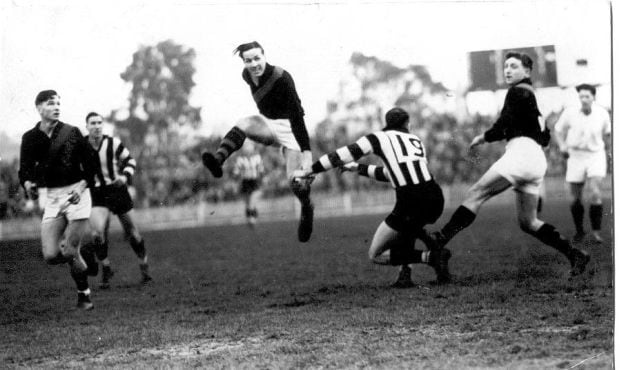On the back of the club’s ‘Don The Sash’ membership campaign launch for this year, essendonfc.com.au takes a closer look at the dominant decades of the sash over Essendon’s proud history.
Today we focus on the 1940s, Essendon’s most successful decade.
Under Dick Reynolds the brilliant triple-Brownlow medallist and captain-coach, the 1940s produced some of Essendon’s greatest ever players including Bill Hutchison, Wally Buttsworth, Harold Lambert, Bill Pearson, Percy Bushby and arguably the best of them all the great John Coleman.
The marvellous Reynolds was only 25 when he was elevated to the position of captain-coach in 1940. Reynolds had been at Windy Hill since 1933 and had already won three Brownlow medals as the best player in the competition. From there he was to remain captain-coach for a further 12 seasons, before becoming a non-playing coach in 1951.
Under King Richard’s reign, Essendon went on to win premierships in 1942, 1946, 1949 and 1950, but it could have been many more. The Dons were in six Grand Finals in succession, and could well have created a new record of five flags in a row had it not been for a heart-breaking Grand Final loss in 1947 by one point and a loss the following year in a Grand Final replay after the first game had been drawn. In the first game Essendon’s terrible kicking saw it finish with 7 goals 27 behinds, almost twice as many scoring shots as Melbourne.
By 1941, World War II was felt by every Australian and had touched every aspect of Australian life. Football attendances understandably fell drastically, with an average of only 66,000 attending games each week. Many clubs also experienced financial difficulties.
Flying Higher explains that Essendon’s team were unsettled with frequent changes due to the uncertainty of players being granted leave from the armed services to play. However, Essendon excelled in 1941 and made finals for a second year in a row under Reynolds.
After comprehensively beating Carlton in the preliminary final, Essendon made it to the Grand Final for the first time since 1924. It was a long 16 years for Essendon supporters, but they would have to wait another year for a flag after the side lost to Melbourne by 29 points.
While World War II was still having a considerable impact on the competition in 1942, a shy, slightly-built footballer named Bill Hutchison arrived at Windy Hill. ‘Hutchy’ was to make his name in League football as one of the most exceptional rovers of all time. In fact his captain and coach Dick Reynolds described ‘Hutchy’ as the best player he’d ever seen. Working in tandem with Reynolds, it was said the pair were majestic on the field. In that year Essendon faced Richmond in the Grand Final at Princes Park, and what a victory it was – Essendon 19.18 (132) to Richmond 11.13 (79). The club had won their first Grand Final since 1924.
The following year, 1943, Essendon again faced Richmond in the Grand Final, but fell agonisingly short by only five points. However more premiership success was to follow as the club moved into its most successful six-year period in its League history. Despite a temporary slump in 1945 when the side finished eighth, it was the return of the power-packed Bombers in 1946.
New players George Hassell, Jack Jones and Bob McClure all made their debuts in 1946 and all went on to play in multiple premierships. Despite a two-point first up loss to Footscray in round 1 the side put together another eight wins on the trot to record its longest winning streak since 1911.

The magnificent Dick Reynolds in action for the Dons.
The Bombers lost only another three games for the season before facing Collingwood in the second semi-final. Gordon ‘Whopper’ Lane came to the rescue for the Bombers with four goals in a drawn game. He managed three more the following week in the 19-point replay win over the Magpies to put the Bombers into the Grand Final for the fourth time in six seasons.
Facing Melbourne in the Grand Final again, officials were quietly confident of victory. But Melbourne booted five early goals in the first quarter to shock Essendon. But it was a different story after half time as the Bombers piled on 11 goals to one in the third term with their supporters going wild. Gordon Lane, kicked a career-high seven goals and the Bombers cruised to a comfortable 63-point win, 22.18 (150) to 13.9 (87).
Despite the narrow Grand Final loss in 1947 and the disappointing loss in the 1948 Grand final replay, a new champion at Essendon was to arrive on the scene in 1949. John Coleman came to the club from Mornington Peninsula club Hastings and rocked the football world by kicking twelve goals and two behinds in his first match of the season against Hawthorn and 100 goals in his first season. These feats have never been matched.
Despite a mid-season slump where Essendon lost five out of six games, the team stormed home with eight straight wins to finish fourth heading into the finals. A huge win over Collingwood then a low scoring win over North put the Bombers into the Grand Final against Carlton for the second time in three years. But this time the result was different. Holding Carlton to just three goals to three quarter time, Essendon’s new sensation John Coleman kicked six goals to bring up his 100 in his debut season, with the Bombers running out 52- point winners. While Coleman’s individual effort was one thing, Essendon as a team was superb and it was a complete premiership victory to finish off the 1940s.
Essendon was even more devastating in 1950. Only one loss for the whole season saw the Bombers finish four wins clear of the competition heading into the finals. Essendon’s one loss that season was against a resurgent North Melbourne by 15 points and a narrow three-point win over the Shinboners in the second semi-final showed that the two teams were evenly matched.
The two teams met again in the Grand Final, North Melbourne’s first since joining the League in 1925. Essendon led at every break to run out 38-point winners to win its first back-to-back flags since 1923-24. Coleman kicked four goals to finish with 120 goals for the year, the best of his record-breaking career.
From Round 1, 1941 to the 1950 Grand Final, the Bombers won 147 games and lost 45 winning four premiership and being runners- up another four times. By 1951 Essendon was looking like winning a third consecutive premiership, but that’s a story for another day.
*With credit to Flying High – History of the Essendon Football Club 1872-1996 by Michael Maplestone.



